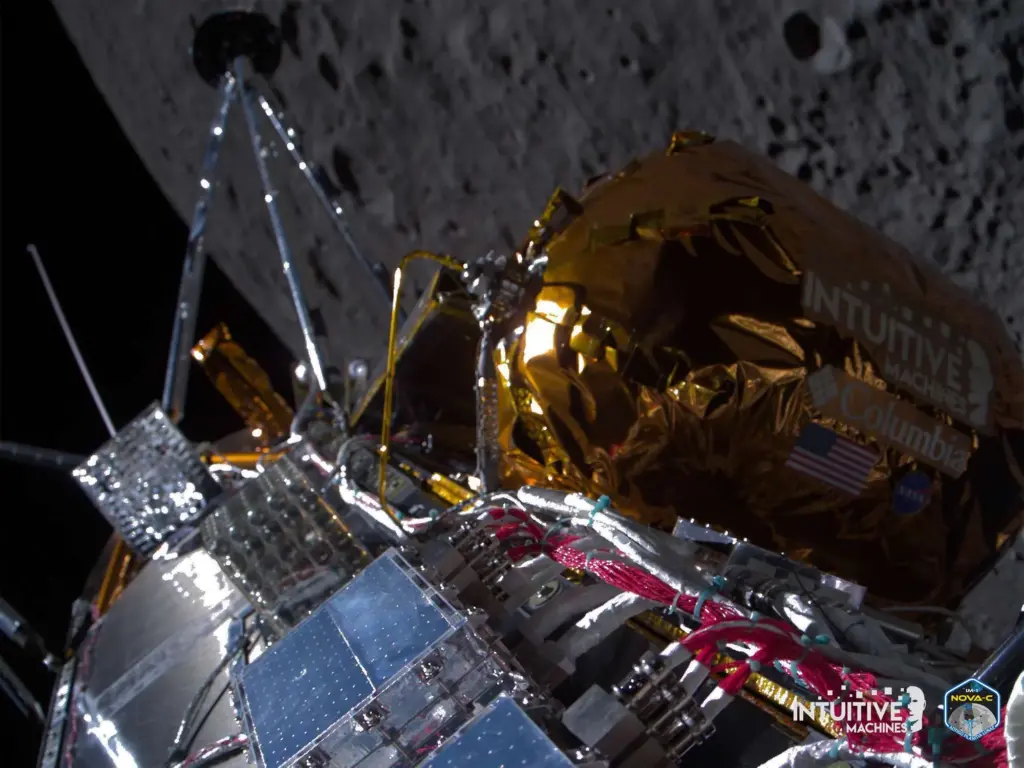
WASHINGTON — Intuitive Machines’ first lunar lander mission entered orbit around the moon Feb. 21, setting up a landing attempt in a day. The company announced on social media that the Nova-C lander, named Odysseus, performed a 408-second burn of its main engine, placing the spacecraft into a circular orbit around the moon at an altitude of 92 kilometers. The maneuver, which changed the spacecraft’s velocity by 800 meters per second, was completed with an accuracy of 2 meters per second.
Intuitive Machines did not disclose the exact time of the burn in its announcement at 10:20 a.m. Eastern. The spacecraft had been on a trajectory that would have taken it about 100 kilometers from the moon around 9:40 a.m. Eastern. The insertion burn came after two trajectory correction maneuvers to refine the spacecraft’s path to the moon, with the company concluding a third planned maneuver was not needed.
The engine, which uses liquid oxygen and methane propellants, was tested in space for the first time in a commissioning maneuver Feb. 16. Company executives said before the launch that successfully completing that test would give them greater confidence that the engine would work as required for a soft landing.
With the spacecraft now in orbit, Intuitive Machines is now moving ahead with plans for a landing attempt on Feb. 22. The landing, near the Malapert A crater in the south polar region of the moon, was originally scheduled for 5:49 p.m. Eastern that day. The company said late Feb. 21 that it revised the landing time to 5:30 p.m. Eastern after flight controllers “analyzed the post-Lunar Orbit Insertion engine burn data and updated the anticipated flight maneuver timing.”
The IM-1 mission is carrying six NASA payloads through NASA’s Commercial Lunar Payload Services (CLPS) program under a $118 million task order. The spacecraft is also carrying six payloads for non-NASA customers, such as artwork, a data archive and a small astronomical telescope. If the spacecraft does land successfully, Intuitive Machines expects to operate it for about a week before the sun sets at the site, ending the mission.
If the landing is successful, Intuitive Machines will become the first non-governmental entity to successfully soft-land on the moon. The Beresheet lander by Israel’s SpaceIL crashed during an April 2019 landing attempt, while the HAKUTO-R M1 lander from Japan’s ispace crashed during its landing attempt in April 2023. Astrobotic’s Peregrine lander, which also had a NASA CLPS task order, suffered a propellant leak shortly after its Jan. 8 launch and aborted plans to orbit and land on the moon, reentering about 10 days after launch.
https://spacenews.com/im-1-lander-enters-lunar-orbit/
Comment: I heard about the launch after the fact. I did hear about the Odysseus lunar lander successfully entering lunar orbit on the car radio earlier today. I’ll try to catch the landing attempt at 5:30 PM Eastern. NASA will be covering it at the link below.
https://plus.nasa.gov/scheduled-video/intuitive-machines-1-lunar-landing/

Thanks for the link. It’s about time we returned to Luna. What’s with the Odysseus name – they intend a homecoming?
delayed to 6:24
leith,
You beat me to it. Missed the first lunar landing while camping. Listened to Walter Cronkite narrate it while watching the near full moon that night. To this day, I’m convinced I made the right decision.
The adjusted landing time is now 6:24pm EST (2324 UTC). No reason given for the delay. Probably just double and triple checking. Maybe they broke out the old log log decitrig slide rules for good measure.
Communications challenge!
Communicating now. https://www.youtube.com/watch?v=8kNhOQvgRdU
Looks like Odie made it to the surface and is communicating. I heard that the team had to do a software install on the fly to get the landing system to work properly. That’s some damned fine coding. Still waiting for video or even photos.
Ars has a good summary of the landing & what the IM team went through in the nail-biting emergency phase. another typically (good kind) American engineering feat. surprise crisis (sometimes just plain screwing up) > fix it under duress > iterate to next task / challenge.
https://arstechnica.com/space/2024/02/a-little-us-company-makes-history-by-landing-on-the-moon-but-questions-remain/
Odysseus is transmitting, but she is not vertical. Got tripped up on touchdown. I had thought she looked a bit top-heavy. But they say the reason was because the landing velocity was three times higher than planned. They still expect to get mission data, or part of it. But at what data rate is unknown as some antennas may not be usable.
https://spacenews.com/im-1-lunar-lander-tipped-over-on-its-side/
Sent or not sent that’s the question:
As TTG I was expecting images.
On Space.com I found this snippet:
Also flying on Odysseus was EagleCam, a camera system built by students at Embry-Riddle Aeronautical University. EagleCam was designed to deploy from Odysseus about 100 feet (30 meters) above the lunar surface and snap photos of the lander’s epic touchdown from below. You can learn more about all 12 of the IM-1 payloads here.
There may not have been a backup for that–well, not only PR wise, ;)–important component?
https://www.space.com/intuitive-machines-odysseus-private-moon-landing-success
But good article on Ars Technica, ked. Thanks.
*****************************
There is still hope. Post landing seven days left for EagleCam to catch its images.
https://eu.news-journalonline.com/story/news/local/volusia/2024/02/23/no-pictures-of-odysseus-landing-yet-but-erau-team-remains-hopeful/72713178007/